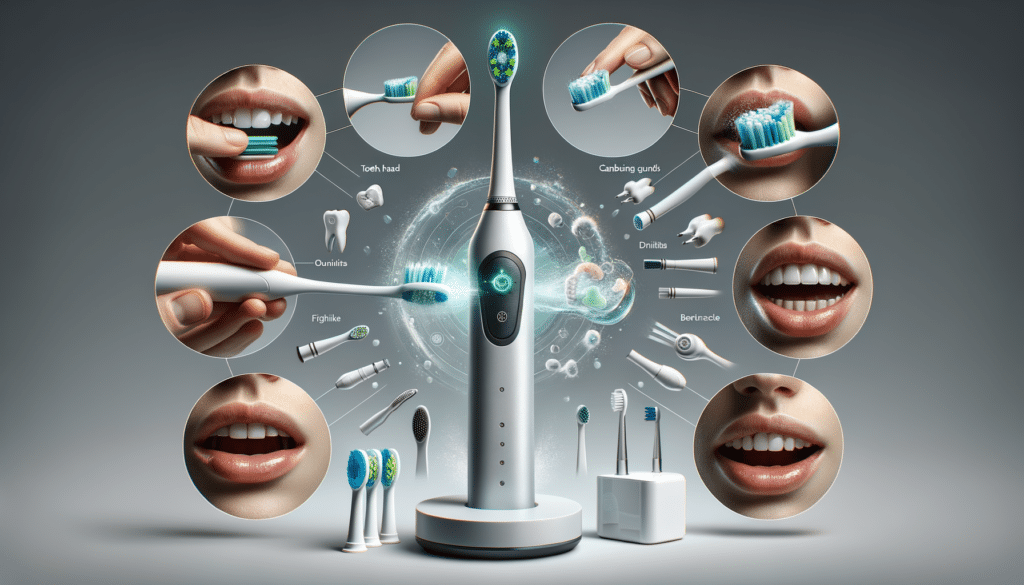How to Use an Electric Toothbrush Properly
Using an electric toothbrush effectively requires a bit of technique to maximize its benefits. Unlike manual toothbrushes, electric versions do most of the work for you. Here’s a step-by-step guide to ensure you’re getting the most out of your electric toothbrush:
- Start with a small amount of toothpaste: Apply a pea-sized amount of fluoride toothpaste to the brush head.
- Position the brush at a 45-degree angle: Place the brush head at a 45-degree angle to your gums.
- Turn on the toothbrush: Before turning it on, position the brush in your mouth to avoid splattering toothpaste.
- Gently glide the brush: Allow the brush to move slowly across each tooth. The bristles should move in a circular motion.
- Brush for two minutes: Most electric toothbrushes have a built-in timer to ensure you brush for the recommended two minutes.
- Rinse and clean: After brushing, rinse your mouth and clean the brush head under running water.
Following these steps can help you achieve optimal oral hygiene. Remember to brush all surfaces of your teeth, including the outer, inner, and chewing surfaces. By using your electric toothbrush correctly, you can maintain a healthy smile and reduce the risk of dental issues.
Can an Electric Toothbrush Whiten Teeth?
Many people wonder if an electric toothbrush can contribute to whiter teeth. While electric toothbrushes are not specifically designed to whiten teeth, they can help remove surface stains more effectively than manual brushes. This enhanced cleaning capability can lead to a brighter smile over time.
Electric toothbrushes often feature oscillating or vibrating brush heads, which provide a more thorough cleaning action. This can help remove plaque and stains caused by foods and drinks such as coffee, tea, and red wine. However, it’s important to note that for significant whitening, professional treatments or whitening toothpaste may be necessary.
Here are some benefits of using an electric toothbrush for maintaining a brighter smile:
- Consistent pressure and motion: Electric toothbrushes maintain consistent pressure and motion, reducing the risk of enamel damage while effectively cleaning teeth.
- Built-in timers: These ensure you brush for the recommended time, which can enhance cleaning and stain removal.
- Advanced brush heads: Some electric toothbrushes offer specialized brush heads designed to target stains and improve the appearance of teeth.
While an electric toothbrush can aid in maintaining a clean and bright smile, it’s essential to maintain regular dental check-ups and consider additional whitening options if desired. Remember, the key to a healthy smile is a combination of effective brushing, flossing, and professional dental care.
Do Electric Toothbrushes Help Gingivitis?
Gingivitis, a common form of gum disease, can cause redness, swelling, and bleeding of the gums. Proper oral hygiene is crucial in preventing and managing gingivitis, and electric toothbrushes can play a significant role in this process.
Electric toothbrushes are known for their ability to remove plaque more efficiently than manual toothbrushes. This is particularly beneficial for individuals with gingivitis, as plaque buildup is a primary cause of gum inflammation. Here are some reasons why electric toothbrushes can be advantageous for gingivitis:
- Effective plaque removal: The oscillating and vibrating motions of electric toothbrushes help dislodge and remove plaque from teeth and gum lines.
- Gentle on gums: Many electric toothbrushes have pressure sensors that alert you if you’re brushing too hard, reducing the risk of gum damage.
- Encourages thorough brushing: Built-in timers ensure you brush for the full two minutes, covering all areas of the mouth.
Studies have shown that using an electric toothbrush can lead to a significant reduction in gingivitis symptoms. It’s important to pair the use of an electric toothbrush with other oral hygiene practices, such as regular flossing and dental check-ups, to effectively manage and prevent gingivitis.
In conclusion, while an electric toothbrush can be a valuable tool in combating gingivitis, it should be part of a comprehensive oral care routine. Consistent use and proper technique can help maintain healthy gums and prevent the progression of gum disease.


